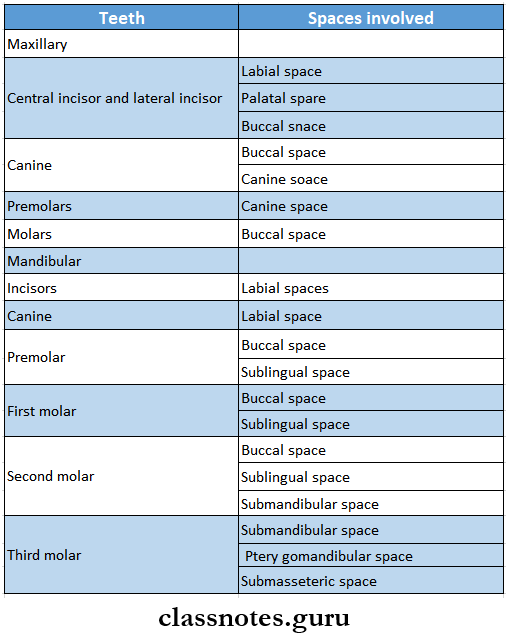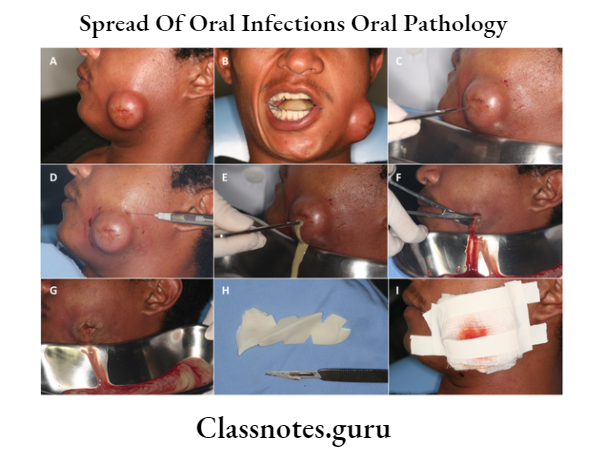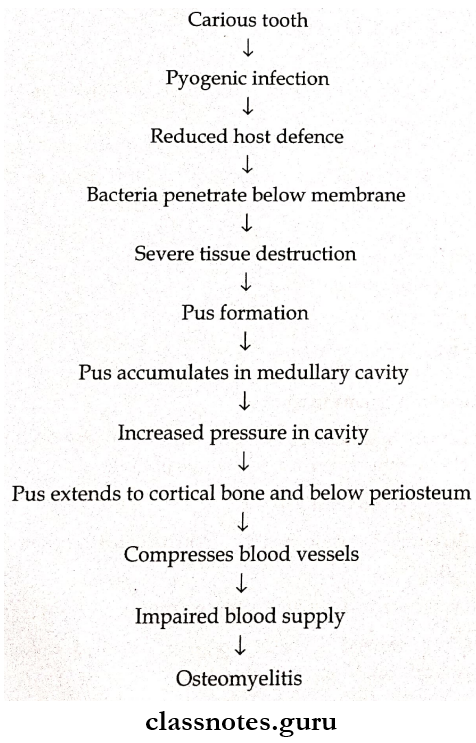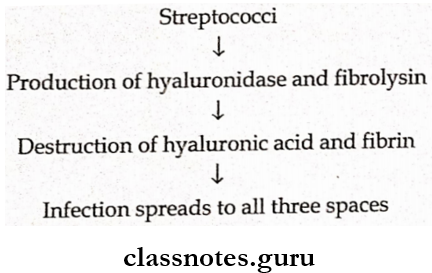Spread Of Oral Infections Important Notes
- Ludwig’s Angina
- Ludwig’s angina is an overwhelming diffuse, suppurative cellulitis, which simultaneously involves the submandibular, sublingual, and submental space.
- Ludwig’s Angina produces a rapidly spreading, large, diffuse, and broad-like aggressive swelling; which involves the upper part of the neck and floor of the mouth bilaterally with brawny induration, swelling causes elevation of the tongue.
- The enlarged tongue may protrude outside the mouth and the condition is called woody tongue.
- Bull neck
- Ludwig’s Angina Complications
- Cavernous sinus thrombosis,
- Meningitis,
- Brain abscess and
- Suppurative encephalitis, etc.
- Death due to asphyxia
- Focal Infection
- Metastases of microorganisms or their toxins from a localized site of infection to any distant part of the body with subsequent injury are called “focal infections.”
- Focus Of Infection
- A circumscribed area of tissue, which is infected by exogenous pathogenic organisms and is usually located near the skin or mucosal surface is called a focus of infection.
- Cellulitis
- Cellulitis is a diffuse inflammation of soft tissues that tends to spread through tissue spaces and along fascial planes
- Causative organisms – streptococci and anaerobes
- Cellulitis Clinical features
- The patient is moderately ill with increased temperature and leukocytosis
- Swelling is painful, diffuse, firm, and brawny
- The overlying skin is inflamed
- Regional lymphadenitis is present
- Treatment
- Administration of antibiotics
- Spread Of infection

- Maxillary Sinusitis
- Maxillary Sinusitis is an acute or chronic inflammation of sinusitis
- Maxillary Sinusitis Features
- Moderate to severe pain in the sinus region
- Discharge of pus into the nose with fetid breath
- Water’s view is a radiographical technique used for it
- Clouding of the maxillary sinus is seen over radiograph
- Cavernous Sinus Thrombosis
- Cavernous Sinus Thrombosis is characterized by the formation of septic thrombi within the cavernous sinus and its numerous communicating branches
- Sources of infection
- External source
- Infection from face
- Internal source
- Periapical abscess
- Otitis media
- Fracture of skull
- Meningitis
- Septicaemia
- External source
- Cavernous Sinus Thrombosis Clinical features
- Tachycardia, tachypnoea
- Stiffness of neck
- Photophobia
- Increased lacrimation
- Proptosis
- Chemosis
- Dilatation of pupil
- Paralysis of extraocular muscles
- Fixation of eyeball
- Complete paralysis of 3rd, 4rd and 6th cranial nerves

Spread Of Oral Infections Short Question And Answers
Question 1. Describe in detail chronic osteomyelitis affecting the jaw.
Answer:
Chronic Osteomyelitis
Chronic Osteomyelitis is defined as the inflammation of bone and bone marrow along with the surrounding periosteum
Chronic Osteomyelitis: Osteomyelitis persisting for more than one month is known as chronic osteomyelitis
Chronic Osteomyelitis Causative Organism:
- Staphylococci
- Streptococci
- Bacteroids
- Actinomyces
Chronic Osteomyelitis Pathogenesis:

Chronic Osteomyelitis Clinical Features:
- Age- before 20 years of age
- Site- Mandibular first molar is commonly affected
- Fever, tachycardia
- Mild and vague pain
- Insidious in nature
- jaw swelling
- Mobility of teeth
- Sinus tract formation
- Purulent discharge
- Anesthesia and paraesthesia of lip
- The affected tooth is carious
Chronic Osteomyelitis Radiographic Features:
- The moth-eaten appearance of lesion
- Ill-defined radiolucency with ragged borders
- Radiolucency with multiple radiopaque foci within it represents sequestra
- A dense zone of radiopacity with faint radiolucency at the margin
Chronic Osteomyelitis Histopathology:
- Accumulation of exudates and pus within medical spaces
- Presence of inflammatory cells like lymphocytes, plasma cells, and macrophages
- Formation of irregular bony trabeculae
- Presence of sequestrum
Chronic OsteomyelitisTreatment:
- Antibiotics- penicillin, metronidazole, clindamycin for 2-4 months
- Sequestromy
- cauterization of bone
- decortication
- Hyperbaric oxygen therapy
Read And Learn More: Oral Pathology Questions and Answers
Question 2. Ludwig’s angina
Answer:
Ludwig’s Angina
- Ludwig’s angina was described by Wilhelm Fredrich Von Ludwig in 1836
- Ludwig’s Angina is rapidly spreading cellulitis invoking simultaneously submandibular, sublingual, and sub-mental spaces
Ludwig’s Angina Etiology:
- Odontogenic infections
- Traumatic injuries
- Infective conditions
- Pathologic conditions
Ludwig’s Angina Predisposing Factors:
- Diabetes mellitus
- HIV infection
- Oral transplant
- Aplastic anemia
Ludwig’s Angina Pathogenesis

Ludwig’s Angina Clinical Features:
- Rapidly spreading, large, diffuse, and broad-like aggressive swelling
- Elevation of tongue leading to open mouth appearance
- Swollen area of the neck is firm, painful, and non fluctuant
- Swelling is bilateral
- Massive swelling in the neck above the hyoid bone results in bull neck
- High fever with chills
- Rapid pulse
- Dysphagia
- Sore throat
- Hoarseness of voice
- Stridor
- Drooling of saliva
Ludwig’s Angina Treatment:
- High dose of antibiotics
- Incision and drainage
- Tracheostomy in case of airway obstruction
Question 3. Capillary and cavernous haemangiomas
Answer:
Capillary And Cavernous Haemangiomas
Hemangiomas are relatively common benign proliferative lesions of vascular tissue origin
Capillary Haemangioma:
- They begin as endothelial cell neoplasms that are absent at birth
- Common in females
- They exhibit two phases of growth
- Proliferative phase
- Occurs from 8-18 months
- Characterized by the increased number of endothelial and mast cells
- Involution phase
- Characterized by slow regression of haemangioma
- Decrease in endothelial and mast cell activity
- Vascular spaces are lined with endothelial cells
Capillary Haemangioma Types:
- Salmon’s patch
- Port-wine stain
- Strawberry angioma
Cavernous Haemangioma:
- Occurs in areas of abundant venous space like lip, cheek, tongue, posterior triangle of neck
- Age-3rd-5th decade of life
- Swelling is compressible, bluish, warm and nontender
- Associated with arteriovenous communication
- Characterized by large, irregularly shaped, dilated, endothelial lining sinuses
- Contains large aggregates of erythrocytes
Capillary Haemangioma Treatment
- Injection of boiling water or hypertonic saline
- Excision
Capillary Haemangioma Complications:
- Ulceration
- Bleeding
- Infection
- High-output cardiac failure
Question 4. Focal infection
Answer:
Focal infection
Focal infection is a localized or general infection caused by the dissemination of micro-organisms or toxic products from a focus of infection
Focal infection Mechanism:
- Spread of pathogenic micro-organisms from their primary site of infection to the distant part of the body via blood vessels or lymphatics
- Spread of toxins liberated by the pathogenic microbes to distant organs either via blood vessels or lymphatics
Focal infection Significance:
- It causes a great number of systemic diseases like
- Arthritis
- Valvular heart diseases
- Gastrointestinal diseases
- Ocular diseases
- Skin diseases
- Renal diseases
Question 5. Cellulitis
Answer:
Cellulitis Definition: It is an acute, edematous, purulent inflammatory process that spreads diffusely through different tissue spaces
Cellulitis Sources of Infections:
- Periapical abscess
- Pericoronitis
- Periodontal abscess
- Osteomyelitis
- Infected post-extraction wound
- Gunshot injuries
- Oral soft tissue infections
- Blood borne infections
Cellulitis Clinical Features:
- Large, diffuse, painful swelling over the face or neck
- The overlying skin appears purplish
- Fever, chills
- Leukocytosis
- Regional lymphadenopathy
- Pus discharging sinuses
Cellulitis Complications:
- Trismus
- Dyspnoea
- Dysphagia
Question 2 Spaces involved in Ludwig’s Angina
Answer:
Spaces Involved In Ludwig’s Angina
- Spaces involved in Ludwig’s angina are
- Submandibular spaces
- Sub-lingual spaces
- Sub-mental spaces
Question 3. Definitions: Focus of infection, focal infection
Answer:
The Focus Of Infection:
- Circumscribed area of tissue, which is infected by exogenous pathogenic organisms and is usually located near the skin or mucosal surface is called the focus of infection
Focal Infection:
- Focal Infection is a localized or general infection caused by the dissemination of micro-organisms or toxic products from a focus of infection
Spread Of Oral Infections Viva Voce
- 2nd and 3rd molars are the most common teeth for the source of infection.
- Submasseteric space is situated between the masseter muscle and the lateral surface of mandibular vaunts
- Canine space is between the anterior surface of the maxillary anti overly log levator muscle of the upper Up
- A tracheostomy is done to ease airway obstruction in Ludwig’s angina
- Cellulitis is a diffuse inflammation of soft tissues
- Pterygomandibular space lies between the inter not pterygoid muscle and ramus of the mandible
- Rheumatic fever occurs due to hypersensitization of tissues to hemolytic streptococci
- Subacute bacterial endocarditis is more often related to dental infection
